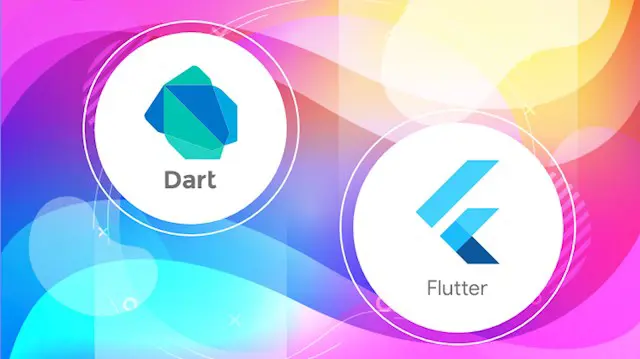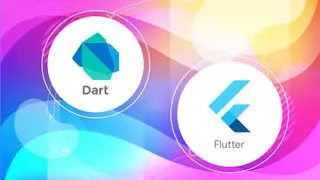
Flutter and Dart | Flutter Dart Programming from Scratch
Flutter Dart Complete Guide for building Android & IOS app with Flutter advanced projects on Dart programming language
Oak Academy
Summary
- Reed courses certificate of completion - Free
Add to basket or enquire
Overview
Flutter, dart, flutter dart, flutter and dart, flutter firebase, dart programming, flutter advanced, flutter project, dart language, dart programing language
Hello there,
Welcome to the “ Flutter and Dart | Flutter Dart Programming from Scratch ” course.
Flutter Dart Complete Guide for building Android & IOS app with Flutter advanced projects on Dart programming language
Flutter is a Google SDK for building native interfaces for iOS and Android using the Dart programming language. Flutter can integrate with existing iOS and Android code bases. It's free and open-source.
Flutter is Google’s UI toolkit for building beautiful, natively compiled applications for mobile, web, and desktop from a single codebase. Flutter dart was originally launched with support for iOS and Android. Flutter 2 was launched as a stable release in March 2021, with support for Windows, macOS, Linux, and web. Flutter runs with dart, a programming language developed by Google. Dart is a strongly-typed, object-oriented language with a familiar C-style syntax. Developers can compile Dart programs into fast native code that runs smoothly on all supported platforms. On the web, dart flutter is compiled to JavaScript code that can run on the browser. Flutter web is composed of three architectural layers: the Flutter framework, which is written in Dart and provides all the widgets that developers use to build their apps; the flutter firebase Engine, written in C++, which provides low-level rendering support.
Flutter is a Google SDK for building native interfaces for iOS and Android using the Dart programming language. Flutter can integrate with existing iOS and Android code bases. It's free and open-source.
Flutter is an open-source UI software development kit created by Google. It is used to develop cross platform applications for Android, iOS, Linux, macOS, Windows, Google Fuchsia, and the web from a single codebase
Dart is a client-optimized language for developing fast apps on any platform. Its goal is to offer the most productive programming language for multi-platform development, paired with a flexible execution runtime platform for app frameworks.
Languages are defined by their technical envelope — the choices made during development that shape the capabilities and strengths of a language. Dart is designed for a technical envelope that is particularly suited to client development, prioritizing both development (sub-second stateful hot reload) and high-quality production experiences across a wide variety of compilation targets (web, mobile, and desktop).
Dart also forms the foundation of Flutter. Dart provides the language and runtimes that power Flutter apps, but Dart also supports many core developer tasks like formatting, analyzing, and testing code.
The Dart language is type safe; it uses static type checking to ensure that a variable’s value always matches the variable’s static type. Sometimes, this is referred to as sound typing. Although types are mandatory, type annotations are optional because of type inference. The Dart typing system is also flexible, allowing the use of a dynamic type combined with runtime checks, which can be useful during experimentation or for code that needs to be especially dynamic
Video and Audio Production Quality
All our videos are created/produced as high-quality video and audio to provide you the best learning experience.
You will be,
-
Seeing clearly
-
Hearing clearly
-
Moving through the course without distractions
You'll also get:
-
Lifetime Access to The Course
-
Fast & Friendly Support in the Q&A section
Dive in now into;
" Flutter and Dart | Flutter Dart Programming from Scratch
Flutter Dart Complete Guide for building Android & IOS app with Flutter advanced projects on Dart programming language" course
We offer full support, answering any questions.
My students says that: Recommended for those who start Flutter from zero like me. I'm a backend programmer, and I know nothing about the mobile realm. Now I can build my own mobile app. I'm really excited!
Flutter & Dart
See you in the course!
Curriculum
-
Course Intro 01:01
-
Introduction to Dart (Flutter and Dart) 19:34
-
Dart Basics 31:07
-
Control and Loop Structures and Operators in Dart 1:13:21
-
Functions in Dart ( Flutter ) 22:56
-
Collection Structures 49:31
-
Object Oriented Programming in Dart ( Programming Language ) 51:38
-
Inheritance and Polymorphism in Dart 23:58
-
Interface and Abstract Class 31:44
-
Functional Programming in dart programming 43:23
-
Exception and Generic Type Concepts 38:26
-
Asynchronous Programming and Future Class 55:15
-
Null Safety 33:09
-
Introduction to Flutter 19:05
-
Environment Setups 49:48
-
Flutter Basics 1:48:26
-
Basics Widgets in Flutter 1:42:40
-
List Types in Flutter 2:08:56
-
Navigation Operations 1:17:23
-
Book List Application 49:06
-
Input Widgets 1:42:16
-
Student Grade Calculator(App) 1:12:15
-
Design Processes in Flutter 1:11:46
-
Using Drawer and Inkwell 1:09:17
-
Http Package Json and Api 1:06:14
-
Introduction to Firebase 35:18
-
Firebase Realtime Database 14:33
-
Authentication with Firebase 03:56
-
Intro to Git and Github Course 04:00
-
Let’s Start to Complete Git and GitHub course? 1:29:10
-
Github 18:59
-
Extra 01:00
Course media
Description
Flutter, dart, flutter dart, flutter and dart, flutter firebase, dart programming, flutter advanced, flutter project, dart language, dart programing language
Hello there,
Welcome to the “ Flutter and Dart | Flutter Dart Programming from Scratch ” course.
Flutter Dart Complete Guide for building Android & IOS app with Flutter advanced projects on Dart programming language
Flutter is a Google SDK for building native interfaces for iOS and Android using the Dart programming language. Flutter can integrate with existing iOS and Android code bases. It's free and open-source.
Flutter is Google’s UI toolkit for building beautiful, natively compiled applications for mobile, web, and desktop from a single codebase. Flutter dart was originally launched with support for iOS and Android. Flutter 2 was launched as a stable release in March 2021, with support for Windows, macOS, Linux, and web. Flutter runs with dart, a programming language developed by Google. Dart is a strongly-typed, object-oriented language with a familiar C-style syntax. Developers can compile Dart programs into fast native code that runs smoothly on all supported platforms. On the web, dart flutter is compiled to JavaScript code that can run on the browser. Flutter web is composed of three architectural layers: the Flutter framework, which is written in Dart and provides all the widgets that developers use to build their apps; the flutter firebase Engine, written in C++, which provides low-level rendering support.
Flutter is a Google SDK for building native interfaces for iOS and Android using the Dart programming language. Flutter can integrate with existing iOS and Android code bases. It's free and open-source.
Flutter is an open-source UI software development kit created by Google. It is used to develop cross platform applications for Android, iOS, Linux, macOS, Windows, Google Fuchsia, and the web from a single codebase
Dart is a client-optimized language for developing fast apps on any platform. Its goal is to offer the most productive programming language for multi-platform development, paired with a flexible execution runtime platform for app frameworks.
Languages are defined by their technical envelope — the choices made during development that shape the capabilities and strengths of a language. Dart is designed for a technical envelope that is particularly suited to client development, prioritizing both development (sub-second stateful hot reload) and high-quality production experiences across a wide variety of compilation targets (web, mobile, and desktop).
Dart also forms the foundation of Flutter. Dart provides the language and runtimes that power Flutter apps, but Dart also supports many core developer tasks like formatting, analyzing, and testing code.
The Dart language is type safe; it uses static type checking to ensure that a variable’s value always matches the variable’s static type. Sometimes, this is referred to as sound typing. Although types are mandatory, type annotations are optional because of type inference. The Dart typing system is also flexible, allowing the use of a dynamic type combined with runtime checks, which can be useful during experimentation or for code that needs to be especially dynamic
Video and Audio Production Quality
All our videos are created/produced as high-quality video and audio to provide you the best learning experience.
You will be,
-
Seeing clearly
-
Hearing clearly
-
Moving through the course without distractions
You'll also get:
-
Lifetime Access to The Course
-
Fast & Friendly Support in the Q&A section
Dive in now into;
" Flutter and Dart | Flutter Dart Programming from Scratch
Flutter Dart Complete Guide for building Android & IOS app with Flutter advanced projects on Dart programming language" course
We offer full support, answering any questions.
My students says that: Recommended for those who start Flutter from zero like me. I'm a backend programmer, and I know nothing about the mobile realm. Now I can build my own mobile app. I'm really excited!
Flutter & Dart
See you in the course!
Who is this course for?
- Anyone who has never programmed before and want to learn Dart and build iOS and Android apps.
- Anyone who know how to code, but are new to mobile development, then take this course to build apps with just one codebase.
- Anyone who have tried Flutter before, but want to get a comprehensive curriculum that covers all the important aspects of Flutter development
- Anyone who wants to deploy to multiple devices from a single codebase: mobile, web, desktop, and embedded devices.
- It's perfect for complete beginners with zero experience for dart
- If you want to building your application with Dart and Flutter application
- Anyone who wants to use Flutter which is a Google SDK for building native interfaces for iOS and Android using the Dart programming language
- Anyone who wants to build beautiful apps easily with Flutter
- Anyone who wants to learn Dart programming language which is very productive.
- Anyone who want to build native-quality iOS and Android apps with Flutter.
Requirements
- You do not need to have any programming background while doing these.
- No prior dart or flutter
- Desire to learn dart flutter
- Computer with access to the internet.
- Willingness and Motivation to successfully complete the course about Flutter
- Desire to learn Flutter and Dart
- Have 10GB of free space on your hard drive.
- Watching the lecture videos completely, to the end and in order.
- Nothing else! It’s just you, your computer and your ambition for flutter dart to get started today
Questions and answers
Currently there are no Q&As for this course. Be the first to ask a question.
Certificates
Reed courses certificate of completion
Digital certificate - Included
Will be downloadable when all lectures have been completed
Reviews
Currently there are no reviews for this course. Be the first to leave a review.
Legal information
This course is advertised on reed.co.uk by the Course Provider, whose terms and conditions apply. Purchases are made directly from the Course Provider, and as such, content and materials are supplied by the Course Provider directly. Reed is acting as agent and not reseller in relation to this course. Reed's only responsibility is to facilitate your payment for the course. It is your responsibility to review and agree to the Course Provider's terms and conditions and satisfy yourself as to the suitability of the course you intend to purchase. Reed will not have any responsibility for the content of the course and/or associated materials.


